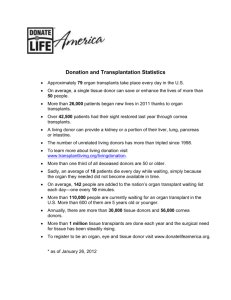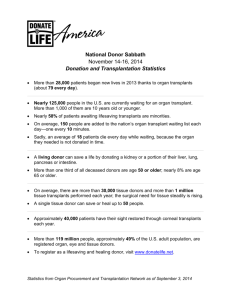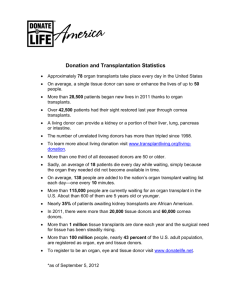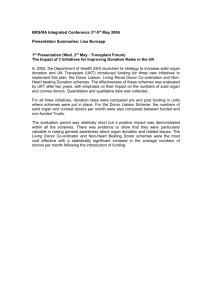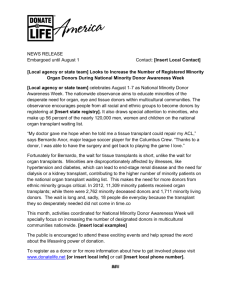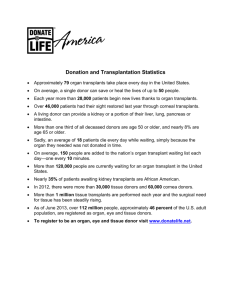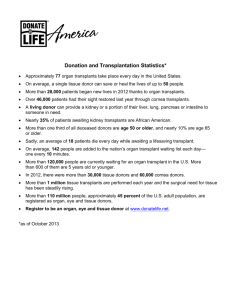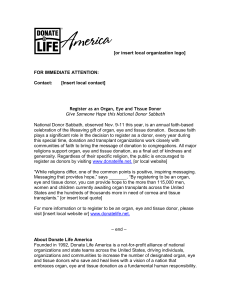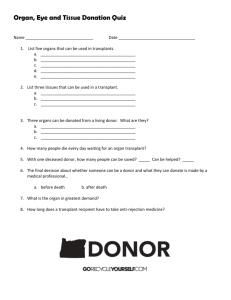Coalition on Donation
advertisement
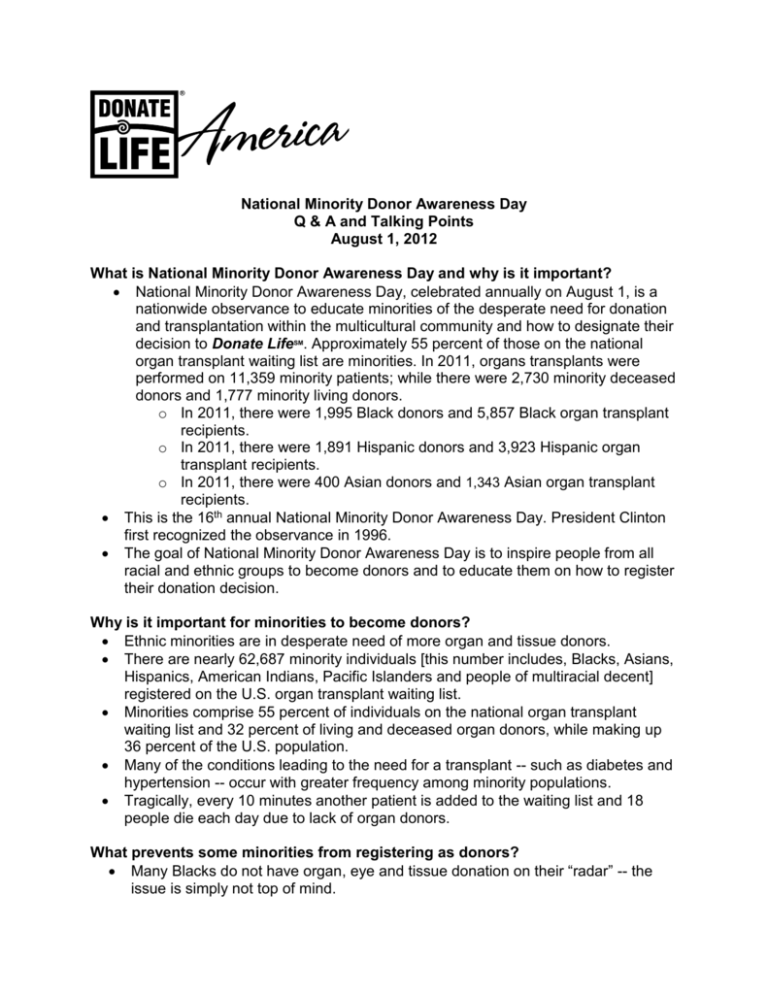
National Minority Donor Awareness Day Q & A and Talking Points August 1, 2012 What is National Minority Donor Awareness Day and why is it important? National Minority Donor Awareness Day, celebrated annually on August 1, is a nationwide observance to educate minorities of the desperate need for donation and transplantation within the multicultural community and how to designate their decision to Donate LifeSM. Approximately 55 percent of those on the national organ transplant waiting list are minorities. In 2011, organs transplants were performed on 11,359 minority patients; while there were 2,730 minority deceased donors and 1,777 minority living donors. o In 2011, there were 1,995 Black donors and 5,857 Black organ transplant recipients. o In 2011, there were 1,891 Hispanic donors and 3,923 Hispanic organ transplant recipients. o In 2011, there were 400 Asian donors and 1,343 Asian organ transplant recipients. This is the 16th annual National Minority Donor Awareness Day. President Clinton first recognized the observance in 1996. The goal of National Minority Donor Awareness Day is to inspire people from all racial and ethnic groups to become donors and to educate them on how to register their donation decision. Why is it important for minorities to become donors? Ethnic minorities are in desperate need of more organ and tissue donors. There are nearly 62,687 minority individuals [this number includes, Blacks, Asians, Hispanics, American Indians, Pacific Islanders and people of multiracial decent] registered on the U.S. organ transplant waiting list. Minorities comprise 55 percent of individuals on the national organ transplant waiting list and 32 percent of living and deceased organ donors, while making up 36 percent of the U.S. population. Many of the conditions leading to the need for a transplant -- such as diabetes and hypertension -- occur with greater frequency among minority populations. Tragically, every 10 minutes another patient is added to the waiting list and 18 people die each day due to lack of organ donors. What prevents some minorities from registering as donors? Many Blacks do not have organ, eye and tissue donation on their “radar” -- the issue is simply not top of mind. Most are not aware of the large number of minorities who are waiting for transplants.' There is a perception that minorities do not have equal access to organs for transplantation. Some are afraid that they will not receive the best medical treatment in a lifethreatening emergency if they were a known “organ donor.” Often there is mistrust on the part of minorities of medical establishments and institutions. Does the church support organ, eye and tissue donation? Every major religion in the United States supports organ, eye and tissue donation as one of the highest expressions of compassion and generosity. Is there a greater need for any particular organ among minorities? Yes. Kidneys are at the top of the list. While 36 percent of the U.S. population is of minority ethnicity, approximately 62 percent [this percentage includes, Blacks, Asians, Hispanics, American Indians, Pacific Islanders and people of multiracial decent] of those waiting for kidney transplants are minorities. Currently, more than 62,000 minority individuals are waiting for kidney transplants. For these patients, the lack of available organs means longer waiting periods on transplant lists, more time spent on dialysis, and sometimes death. Why is the need for kidneys so high among minorities? Minorities are disproportionately affected by illnesses that can lead to end-stage renal disease and the need for dialysis or a kidney transplant. These diseases include high blood pressure [hypertension] and diabetes. How much does it cost to be a donor? There is no cost to the donor’s family or estate. Is it true that rich people and celebrities get preferential treatment when it comes to getting a donor organ? No. When you are on the transplant waiting list for a donor organ, what really counts is the severity of your illness, time spent waiting, blood type and other important medical information. One’s celebrity status does not play a part in the decision. The transplant waiting list is “blind” to ethnicity, gender, connections and wealth. When a celebrity needs an organ, it tends to get more attention from the media, so it may seem like they are getting special consideration. However, they have been placed on the waiting list like everyone else. What are the benefits of being an organ, eye and tissue donor? Knowing that you have the power to give someone else a chance to live a healthy productive life is the greatest gift of all. A single donor can save or enhance the lives of more than 50 people. Donation is a consolation to the donor family knowing that their loved one helped to save and enhance the lives of others. How can I become an organ, eye and tissue donor? Sign up in your state donor registry. For instructions, visit www.donatelife.net/register-now and click on your state. Always remember, it is important to tell your family members that you have decided to become a donor so that they will understand and support your decision. What is being done to increase the number of minority donors? Donate Life America created radio, television and print public service announcements to educate and urge more minorities to become organ, eye and tissue donors. Also, other initiatives spearheaded by member organizations are taking place throughout the nation such as: o Informing religious congregations about the need for donors o Youth education and school programs o Presentations to civic organizations What can I do to increase organ, eye and tissue donation in my community? Tell family and friends about your decision to Donate Life. Ask them to get the facts, and consider registering as a donor. Go to www.donatelife.net for tips and tools for educating members of your community about the lifesaving gift of organ, eye and tissue donation. These may include: o Placing articles in newsletters o Hanging posters around the community o Handing out brochures o Including flyers in church bulletins o Using www.donatelife.net web banners on your personal or organizational Web site o Wearing Donate Life lapel pins What is Donate Life America and how is it funded? Founded in 1992, Donate Life America’s mission is to serve as a national voice and inspire all people to save and enhance lives through organ, eye and tissue donation. Donate Life America is a not-for-profit organization funded through contributions from the public and affiliated organizations. Its vision is an organ, eye or tissue transplant for everyone in need. * as of March 20, 2012
